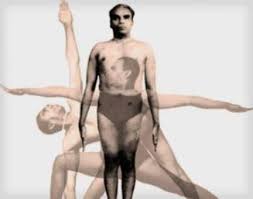Posture – What is it For?

This past weekend with Prashant Iyengar continued with a clarification that he is not anti-posture. As I mentioned before, class with Prashant is not something that we expect as students of modern yoga, but he knows this as well. His use of asana is for explorations and experimentations, and he approaches concepts with the idea that any yoga in a classroom or studio is only for the learning process. The actual knowledge process of yoga has to happen within our own practice with knowledge of our own parameters and paradigms. But what is that knowledge process beyond knowing what a pose is?
He made the point earlier that postures are “doing” and we have to do posture in order to make space, bring sensation, change parameters, etc…However, in an asana is where we stay, where we explore, where we understand, and where we take the next steps beyond : Pranayama (breath), Pratyahara, (sensitivity), Dharana (concentration), Dhyana (meditation), and Samadhi (enlightenment of yoga). You won’t be doing a lot of complex or showy posture in his classes because “intricacies can only happen in simple posture.”
Asanas are where we have space and time for the breath and the mind. He reminded us of the sutra on Pranayama, Chapter II number 50, where it is said that the regulation of breath takes place according to “place” (desa) and “time” (kala) and with “reflection” (samkhya). If we are externally focused on a “good posture” or complex posture for show, then there is no room for the breath or for yoga.
In this class he laid out a foundational understanding of how to look at asanas through the lenses of BODY, BREATH, and MIND-set addressals. As you do a posture, within an asana, you have to look at all the ways the body, mind, or breath is the doer, the actor, the recipient, the observer, the beneficiary, etc…Taking one asana, Trikonasana (triangle) for example, and using it as a tool to gain knowledge through the use of the mind in certain areas, the breath in certain areas, the placement of the body parts in different ways to effect change, its place in the sequence, etc…
All of this requires reflection and study. We cannot keep going in and out and in and out of posture and think that we are gaining knowledge. Yes, it is useful to “do”, but it is not the end. Taking things on the overt action, we may think that a twisting posture brings a twisted mind, but truly a “twisting asana can lead us to a straight mind” when used properly for yoga.
He left us with acknowledgement that he “had given us almonds and not popcorn” and that it was enough for the day (drop mic at exactly 9:30am). With just popcorn, you can eat handfuls, but with almonds they are precious and more filling…digest until tomorrow…